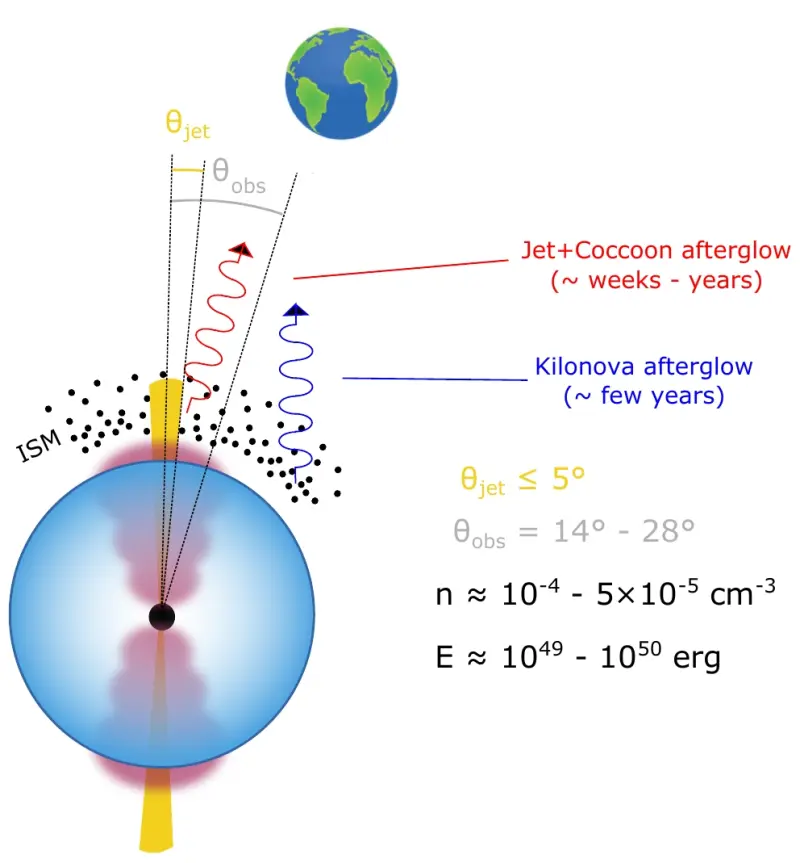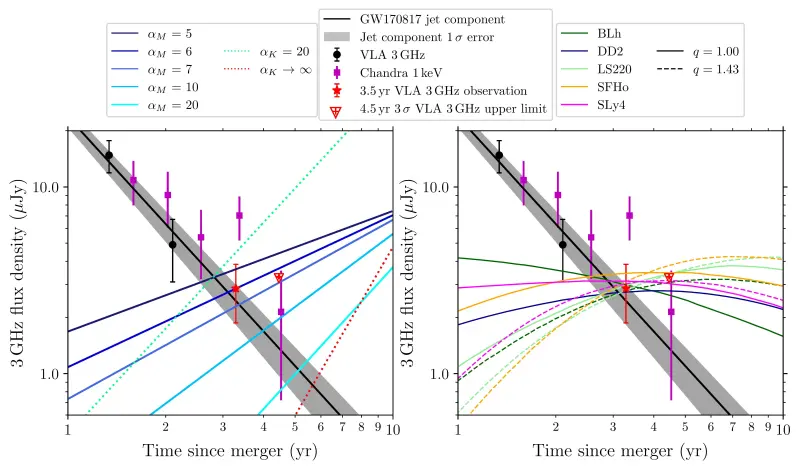PhD Thesis
Binary mergers and peculiar core-collapse supernovae
During the course of my PhD thesis, I have worked on radio observations of transients like the merger of neutron stars and core-collapse supernovae. Here is a brief description of my work.
EMGW - Electromagnetic follow-up of Gravitational Wave events

Image credit: www.ligo.caltech.edu/image/ligo20211107a
Gravitational waves, a new way to probe the universe, were first predicted by Albert Einstein in 1916. It took nearly a 100 years, for them to be detected for the first time and finally in 2015, a merger of two black holes was detected by the Light Interferometer Gravitational-Wave Observatory (LIGO) detectors in Livingston, Louisiana and Hanford, Washington, USA. The 2017 Nobel Prize in Physics was awarded to Dr. Rainer Weiss, Dr. Barry C. Barish and Dr. Kip S. Thorne for contributions to building the LIGO detectors and for the detection of gravitational waves. Since this first discovery, three observing runs (O1, O2, O3) have been completed as of 27 March 2020 17:00 UTC, with many compact object mergers being discovered, most of which are binary black hole mergers. The fourth observing run O4 is currently ongoing.
GW170817 - A binary neutron star merger

Of all the events discussed above, GW170817 stands out as a milestone event, the first binary neutron star merger to be observed with gravitational waves and light by many observatories all around the world. Initial UV-optical-IR quasi-thermal emission has been attributed to r-process nucleosynthesis, a proposed method for the production of some of the elements in the universe like gold, platinum, uranium, helping solve an age old mystery of the formation of these heavy elements. A delayed non-thermal afterglow was observed in the X-rays (radio) at ≈ 9 days (≈ 12 days) from merger. The figure on the left shows the current accepted model of GW170817 - a successful relativistic jet (yellow) from the merger remnant (central black circle) bored through the slower cocoon material (brown) and interacted with the ambient medium leading to non-thermal emission along with the even slower isotropic ejecta (blue) responsible for the early quasi-thermal emission (UV-optical-IR); this agrees with all the follow-up observations till date.
Radio observations from world class radio interferometers like the NRAO facility, the Jansky Very Large Array (VLA) and modelling played a key role showing that the jet was structured and narrowing down various physical parameters of the ambient medium. On the timescale of a few years, models suggest that the isotropic kilonova ejecta will interact with the surrounding medium and produce non-thermal emission, causing the source to rebrighten.

One of the goals of my PhD thesis was to study late time radio emission from GW170817 in search of this expected kilonova afterglow or constrain physical parameters in the case of a non detection. Our deepest VLA 3 GHz observations of the GW170817 field at ≈3.5 and ≈4.5 years since merger shows no evidence of a rebrightening (still follows the decaying part of the jet+cocoon emission, see plots below), helping to constrain the energy-speed distribution of the kilonova ejecta (see Balasubramanian et al. 2021 and Balasubramanian et al. 2022). We were also able to comment on the equation of state of neutron stars from our upper limits.

Peculiar radio bright core collapse supernovae
Radio observations of some core-collapse supernovae (SNe) show variations in their radio luminosity from the expected decaying trend. The study of such peculiar SNe can provide clues about the pre-SN evolution of massive stars by tracking the mass-loss histories of their progenitors and providing insights into the physics through the properties of the surrounding circum-stellar medium (Soderberg et al. 2005, Wellons et al. 2012, Palliyaguru et al. 2019). The mechanism of radio emission in these cases in attributed to synchrotron like emission from the interaction of the SN shock wave with the electrons in the interstellar medium with some modifications (e.g. see models discussed in Chevalier 1998. Type Ibc SNe are a subclass of SNe which lack hydrogen features in their spectra as their progenitors shed their H-envelopes many years before collapse.
I led the late time (~14 years since explosion) study of the radio rebrightening Type Ibc SN2004dk (Balasubramanian et al. 2021). This is the first SN of its kind to be observed (at the frequency of 340 MHz) by the VLA Low Band Ionospheric and Transient Experiment (VLITE) experiment on the VLA. Such observations can help track the mass-loss of the pre-SN progenitor star and provide insights into stellar evolution.

We find that our observations of this SN is consistent with the SN shell strongly interacting with the surrounding H-rich medium (change in density) prepared by mass loss from the progenitor before the SN explosion. The blue curve that does not fit the data well, assumes a decreasing density as a function of radius, while the red curve indicates a change in the density of the medium.